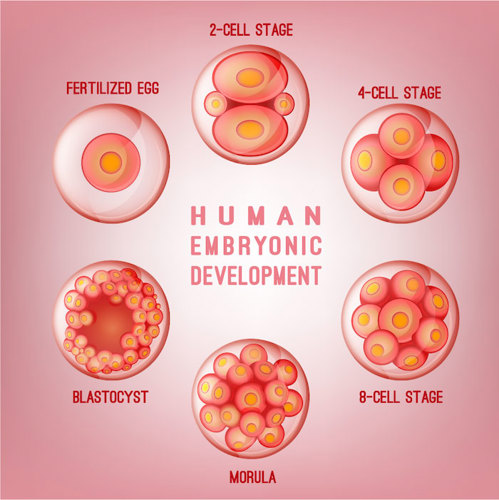
How are chimeras possible?
September 27, 2007

- Related Topics:
- Rare events,
- Developmental biology,
- Chimera
A high school student from South Africa asks:
“Your article on chimeras had me enthralled, but could you please explain more in depth how it is possible for 2 zygotes to fuse and actually what should have been two people ends up as one? Shouldn’t this be impossible?”
It sure sounds impossible! When two embryos fuse, why don't you get someone with two heads, four arms, and 20 toes? And why don't the two embryos reject each other?
It's all a matter of timing. At very early stages, all the cells in an embryo are the same. So adding extra cells isn't a problem.
And the cells from the two embryos can't really tell each other apart. So the new neighbors – cells from the two different embryos – happily intermingle.
To understand how this works, we need to look at an early embryo. Imagine you're watching a baby develop from the very early stages. After the sperm fertilizes the egg to create a zygote, the zygote begins to divide. It starts as one cell, then becomes two cells, then four cells, then eight cells, etc.
Once the embryo reaches about 100 cells, it's called a blastocyst, which is a hollowed out ball of cells. Inside this ball is a group of cells called the inner cell mass. These cells will eventually develop into a baby.

The cells in the inner cell mass are embryonic stem (ES) cells. ES cells – and all earlier cells in the zygote – have the special property of being pluripotent. This means that they can develop into any type of cell in the body. They haven't made up their minds yet, so they're called 'undifferentiated'.
At this point, the embryo is like a lump of clay. Just as an artist can mold a lump of clay into a statue, this ball of ES cells will eventually become a human being.
At first, any part of the clay – or embryo – can become the head, the arms, or the legs. But once a certain piece of clay has committed to becoming an arm, it stays an arm. Likewise for the cells in the embryo.
Now let's go back to the fertilization step. This time, imagine that instead of just one egg, you have two eggs. And each egg gets fertilized by a different sperm. Normally, these two embryos would develop into fraternal twins.
But sometimes-and no one really knows why-these two embryos fuse together into one embryo. And in most cases, you still end up with a normal human being.
Why? Remember that at this stage, both embryos are made up of pluripotent cells. These cells can be molded into any type of cell. Just like combining two batches of unmolded clay, fusing two embryos will give you a new ball of cells. This new ball can then be molded into a head, arms, and legs.

But what if you combined the two lumps of clay after you started making a head and arms and legs? Instead of getting a single normal statue, you'd end up with quite a mess: two statues fused together. In later stage embryos, this type of fusion just doesn't happen successfully.
So chimeras can form because the embryonic cells haven't yet decided what they'll become. But once they decide, how do the two batches of cells stay together? Why don't they reject each other like a patient can reject a new kidney?
Let's think about why our immune system rejects other people's tissues. During development, our immune system needs to learn what's foreign and what isn't. That way, the immune system will only destroy cells that invade the body, and it will leave the body's own cells alone. To the immune system, transplanted organs are foreign invaders.
Because our immune system can't see inside our cells, it can't look at DNA to figure out if a cell is foreign. Instead, it looks at proteins on the outside of the cells.
The immune system memorizes the proteins on the body's own cells and calls these proteins 'self'. It learns not to destroy a cell with 'self' proteins on its outside. (The specific proteins that are displayed depend on the DNA inside the cell.)
This learning process happens at a much later stage than when a chimera is first formed.1 As it is being trained, the immune system will see cells from both embryos. So its list of 'self' proteins will include proteins from both embryos. Even though the two embryos have different DNA and different surface proteins, the immune system learns not to destroy cells from either embryo.
It's sort of like the Disney movie The Fox and the Hound. Tod is a young fox and Copper is a puppy, but they're great friends. They get along with each other because they meet when they're very young. They don't yet know that foxes and dogs shouldn't be friends.
The two embryos that form a chimera work the same way. At an early stage, they haven't learned to 'dislike' each other. But just like a grown-up hound that meets a fox, the immune system of an adult will reject an organ transplant from another person.
Chimeras seem to be pretty rare among humans (although no one really knows for sure). But if chimeras look just like you and me, how do we even know if someone is a chimera?
Ways to detect a chimera
First, if a chimera is made from a female and a male embryo, the chimera might end up with both male and female parts. This is called hermaphroditism.
Second, sometimes chimeras have patchy skin or eye color, or even two different colored eyes! It's pretty easy to imagine how this might happen.
Let's say that one of the original embryos has genes for brown eyes, and the other has genes for green eyes. If cells from both embryos help form both eyes, then the chimera might end up with patches of brown and green in both eyes. And if one eye is made of cells from one embryo, and the other eye comes from cells from the other embryo, then the chimera might have one brown eye and one green eye.
Finally, sometimes we learn that people are chimeras by looking at their DNA directly. Let's take the case of Karen Keegan. In 1998, Karen needed a kidney transplant, so doctors checked to see if anyone in her family could be a donor. They took blood from Karen and her three sons and looked at the DNA. What they found was incredible. Two of her sons had DNA that didn't match their mother's DNA!2
But when they looked at DNA from Karen's skin, hair, and bladder, they found that it matched the two sons' DNA. It turned out that Karen was a chimera. Her blood cells came from one embryo, but the rest of her tissues came from a different embryo.
People who have received bone marrow transplants are actually chimeras, too. Bone marrow transplants are used to treat certain blood diseases and cancers. In these transplants, the doctor destroys the patient's bone marrow with special drugs or radiation. Then the doctor puts in new bone marrow from a donor.
These new bone marrow cells have DNA that's different from the patient's own DNA. And because bone marrow stem cells make blood, the patient's blood cells will have different DNA than the cells in the rest of his or her body.
All these examples show just how flexible embryos are at very early stages. They also show why ES cells are one of the holy grails of medicine. If we can control the flexibility of ES cells, we may be able to cure people of diabetes, Parkinson's, and many other diseases. Thank you, chimeras, for helping point the way!

Author: Ruth Tennen
When this answer was published in 2007, Ruth was a Ph.D. candidate in the Department of Cancer Biology, studying telomerase regulation in cancer and stem cells in Steve Artandi's laboratory. Ruth wrote this answer while participating in the Stanford at The Tech program.
 Skip Navigation
Skip Navigation
